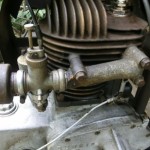Home › Forums › The Main Forum Area › General talk and discussion › Fuel tank sealant
- This topic has 2 replies, 3 voices, and was last updated 10 years, 10 months ago by
 vhgmcbuddy.
vhgmcbuddy.
-
AuthorPosts
-
January 22, 2015 at 5:16 pm #11512
 wristpinParticipant
wristpinParticipantBefore I acquired my Lambretta it had stood unused for twelve years and while the tank was not gummed or heavily corroded it had light interior rusting and does continually shed some very fine rusty sediment that manages to pass through the tank outlet filter, an additional line filter and the gauze on the carb inlet and causes intermittent needle valve leakage.
Bit the bullet this afternoon and pulled the tank out and have read up on kits such as the one from Frost (Por) that includes a detergent, a rust neutraliser and the sealant.
I would like to hear from anyone who has actually used this or any other similar product with any does or don’ts and any experiences, good or bad.January 22, 2015 at 6:24 pm #11513 vhgmcbuddyMember
vhgmcbuddyMemberI used a kit from Tank Care Products (https://www.tankcareproducts.co.uk/) on my Trusty fuel tank. I had originally thought that the tank would be too far gone to save. It was very badly corroded inside and out with many pinholes. My fuel tank is now as good as new, no leaks and no rust.
The most critical part of the procedure was heating the tank and the actual sealant. I have a log burning stove, so placed the tank on top until it was warm, but still OK to touch with bare hands. I heated the sealant in the microwave oven. I set the oven to it’s lowest power and zapped the sealant in 10 second bursts until it was about the consistency of milk. Once the sealant was nice and runny, I mixed in the hardener and poured into the warm tank. I then bunged the filler hole with a cork bung, as I didn’t want the cap coating. You then need to quickly rotate the tank around and around so the sealant can flow over all surfaces while it is still runny. It will begin to cure the moment it is poured into the tank, so speed is of the essence. If the tank isn’t warm, the sealant will cure too quickly and not uniformly coat the inside surfaces.
The tank care products website has some very helpful movies in the Q&A section.Hope this helps,
Sean
January 23, 2015 at 5:19 pm #11514 vhgmcbuddyMember
vhgmcbuddyMemberIf it is of any interest, I did my Landrover fuel tank about ten years ago when I was restoring it, The tank was very rusty inside, I used a product called SLOSH ! you do not have to mix a hardener with it, and all I can say, is that after ten years the coating is still there, and I have not had any trouble since. Best Of Luck!
-
AuthorPosts
- You must be logged in to reply to this topic.
